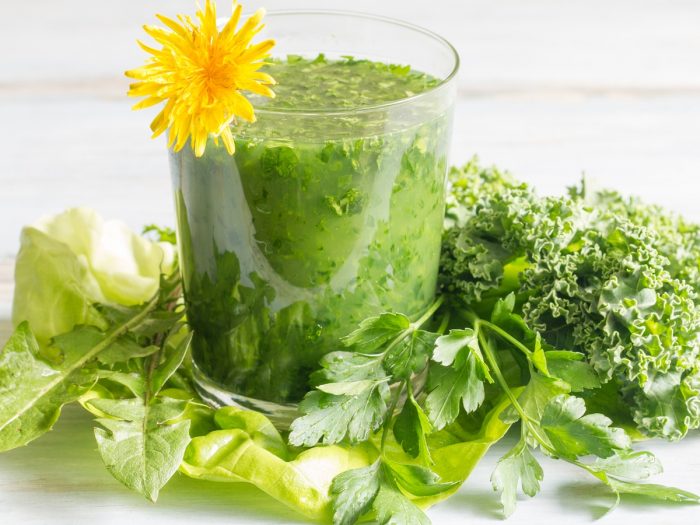Many people see dandelion greens as an annoyance in their yard, but these greens are packed with nutrients and can provide numerous unexpected health benefits.
What are Dandelion Greens?
Dandelion greens are the leaves of the dandelion plant, which is easily recognizable by its yellow flower and its status as a weed in yards around the world. Scientifically known as Taraxacum officinale, dandelions should not be seen as a pest or an invasive weed, but rather as a viable source of green vegetables that can deliver a huge amount of nutrients to your diet. Yes, dandelion greens are edible, although before you start picking the leaves from these common plants, be sure they haven’t been treated with herbicides or any other chemicals. Cultivating dandelion plants for their leaves is quite common in parts of the world where these leaves have gained popularity. [1]
| Serving Size : | |
|---|---|
| Nutrient | Value |
| Water [g] | 85.6 |
| Energy | 45 |
| Energy [kJ] | 188 |
| Protein [g] | 2.7 |
| Total lipid (fat) [g] | 0.7 |
| Ash [g] | 1.8 |
| Carbohydrate, by difference [g] | 9.2 |
| Fiber, total dietary [g] | 3.5 |
| Sugars, total including NLEA [g] | 0.71 |
| Calcium, Ca [mg] | 187 |
| Iron, Fe [mg] | 3.1 |
| Magnesium, Mg [mg] | 36 |
| Phosphorus, P [mg] | 66 |
| Potassium, K [mg] | 397 |
| Sodium, Na [mg] | 76 |
| Zinc, Zn [mg] | 0.41 |
| Copper, Cu [mg] | 0.17 |
| Manganese, Mn [mg] | 0.34 |
| Selenium, Se [µg] | 0.5 |
| Vitamin C, total ascorbic acid [mg] | 35 |
| Thiamin [mg] | 0.19 |
| Riboflavin [mg] | 0.26 |
| Niacin [mg] | 0.81 |
| Pantothenic acid [mg] | 0.08 |
| Vitamin B-6 [mg] | 0.25 |
| Folate, total [µg] | 27 |
| Folate, food [µg] | 27 |
| Folate, DFE [µg] | 27 |
| Choline, total [mg] | 35.3 |
| Vitamin A, RAE [µg] | 508 |
| Carotene, beta [µg] | 5854 |
| Carotene, alpha [µg] | 363 |
| Cryptoxanthin, beta [µg] | 121 |
| Vitamin A, IU [IU] | 10161 |
| Lutein + zeaxanthin [µg] | 13610 |
| Vitamin E (alpha-tocopherol) [mg] | 3.44 |
| Vitamin K (phylloquinone) [µg] | 778.4 |
| Fatty acids, total saturated [g] | 0.17 |
| 14:0 [g] | 0.01 |
| 16:0 [g] | 0.15 |
| 18:0 [g] | 0.01 |
| Fatty acids, total monounsaturated [g] | 0.01 |
| 18:1 [g] | 0.01 |
| Fatty acids, total polyunsaturated [g] | 0.31 |
| 18:2 [g] | 0.26 |
| 18:3 [g] | 0.04 |
| Sources include : USDA [2] | |
Dandelion greens have a pleasant, yet slightly bitter taste, as well as a wide variety of culinary and medicinal uses. Dandelion greens are more nutritionally dense in comparison to other popular leafy greens but may be more difficult to integrate into recipes, due to their bitter taste.
Dandelion Greens Nutrition
The nutritional profile of these greens includes huge levels of vitamin K (more than 500% of your daily requirement per serving), as well as very high levels of vitamin A and C. These greens also contain moderate amounts of calcium, iron, manganese, B vitamins, dietary fiber, and other active ingredients and compounds. [3]
In a single cup of these greens, there are less than 25 calories, 1.5 grams of protein, and a negligible amount of fat.
Dandelion Greens Benefits
The notable health benefits of dandelion greens include regulating blood pressure and lowering inflammation. These greens also help in detoxifying the body, regulating diabetic symptoms and digestion, and strengthening bones, among others.
Skin Care
With a good amount of vitamin E, C, A, and K, these greens are excellent for improving skin health. These vitamins act as antioxidants, helping to reduce inflammation and oxidative stress on the body’s largest organ, reduce the appearance of wrinkles, age spots, and blemishes. [4]
Chronic Disease
In addition to anti-inflammatory compounds, the concentrated nutrients found in these greens can help to cut down on oxidative stress that may lead to chronic diseases. [5]
Improves Digestion
The high fiber content of these greens can help boost gastrointestinal health by regulating peristaltic motion and improving nutrient uptake. This can also prevent symptoms of constipation, diarrhea, and other stomach issues. [6]

Dandelion juice is healthy for people with high blood pressure. Photo Credit: Shutterstock
Reduces Inflammation
Studies have found that dandelion greens can prevent the release of certain inflammatory molecules in the body, thus helping to reduce swelling and irritation both on the skin and in various organ systems and joints. [7]
Increases Bone Density
The broad range of minerals present in these greens makes them a great booster for bone mineral density, as well as the prevention of osteoporosis and other age-related diseases. [8]
Detoxify the body
Perhaps best known for their diuretic properties, dandelion greens can help to cleanse the system by flushing out the toxins and reducing strain on the kidneys, liver, and metabolic system. [9]
Reduces Blood Pressure
Research has shown that these greens can lower blood pressure and reduce strain on the cardiovascular system, thus lowering your risk of heart attack and stroke. [10]
While it is used in several natural and folk medicines, its effects on blood pressure certainly need to be supported with further research.
Dandelion Greens in Diet
Despite their taste, there are many great ways to include dandelion greens in your diet, including as a normal salad green, provided you use a citrus-rich or sweet vinaigrette to counter the taste of the greens. You can also saute or braise the greens, which should reduce some of the bitterness. Many people enjoy blending these greens into their morning vegetable smoothies, as the other ingredients can cover the bitter taste. You can throw these leaves into any thick and hearty soups, stews, and curries, or chop up the greens to make a tangy pesto for your pasta!
